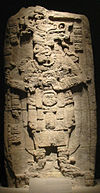Wikipedia:Today's featured article/February 17, 2011
Maya stelae are monuments that were fashioned by the Maya civilization of ancient Mesoamerica. They consisted of tall sculpted stone shafts and were often associated with low circular stones referred to as altars, although their actual function is uncertain. Many stelae were sculpted in low relief, although plain monuments are found throughout the Maya region. Stelae became closely associated with the concept of divine kingship and declined at the same time as this institution. The production of stelae by the Maya had its origin around 400 BC and continued through to the end of the Classic Period, around 900 AD, although some monuments were reused in the Postclassic (c. 900–1521 AD). The major city of Calakmul in Mexico raised the greatest number of stelae known from any Maya city, numbering at least 166, although they are very poorly preserved. Stelae were essentially stone banners raised to glorify the king and record his deeds, although the earliest examples depict mythological scenes. Imagery developed throughout the Classic Period, with Early Classic stelae (c. 250–600 AD) displaying non-Maya characteristics from the 4th century AD onwards, with the introduction of imagery linked to the central Mexican metropolis of Teotihuacan. As the Classic Period came to an end, stelae ceased to be erected, with the last known examples being raised in 909–910 AD. (more...)
Recently featured: Climate of Minnesota – John Wark – Star Trek: The Motion Picture
